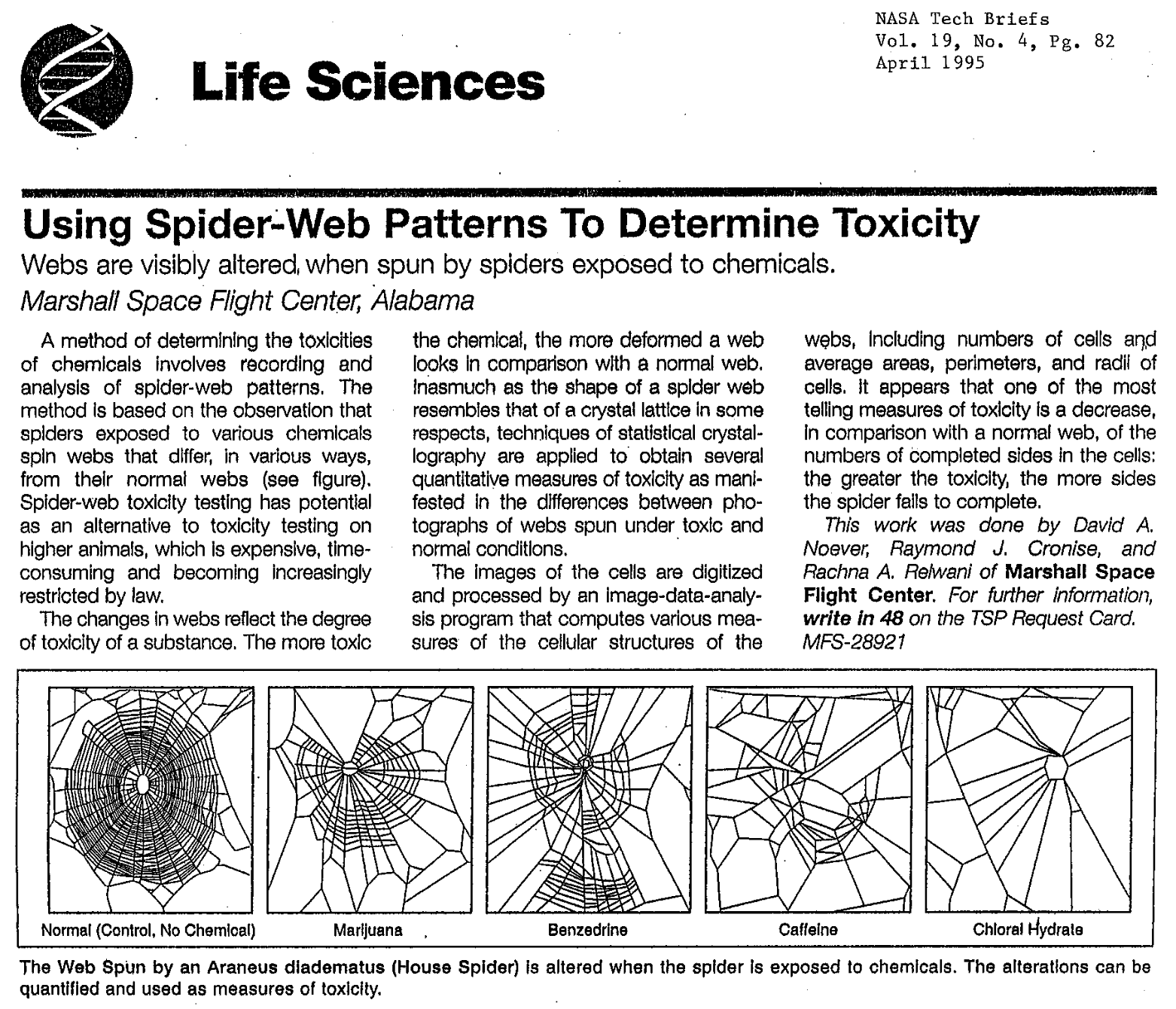In the vast expanse of space exploration, one wouldn't expect NASA, dedicated to unraveling the mysteries of the cosmos, to dabble in the peculiar world of spider behavior and drugs.
Yet, once upon a time, the scientists at NASA embarked on an unconventional experiment: getting spiders high on a cocktail of mind-altering substances.
This unexpected venture into the world of arachnids and their reactions to drugs led to a fascinating exploration of how these eight-legged creatures weave their webs while under the influence, ultimately revealing a strange parallel between their behavior and that of humans.
So, sit back and let us take you on a journey through the web of intrigue that is NASA's surprising study of spiders on drugs.
The study's roots can be traced back to a 1948 experiment by Swiss pharmacologist Peter N. Witt.
The Origins: Peter N. Witt's Experiment
In 1948, Peter N. Witt embarked on a groundbreaking experiment to investigate the effects of drugs on spiders. He administered various substances, such as LSD, mescaline, and amphetamines, to spiders and observed how their web-building behavior changed. Witt's experiments aimed to learn more about the drugs' neurological impacts and potentially provide insights into human drug use.
Witt discovered that different substances led to distinctive changes in the spiders' web-building behavior. For example, webs created under the influence of LSD were more irregular and chaotic, while those exposed to mescaline showed a slight increase in web size. This pioneering work laid the groundwork for future research in the field.
NASA's Study: Taking Witt's Research Further
NASA's study took Witt's research further by testing spiders with a wider variety of substances, including caffeine.

Surprisingly, caffeine, a stimulant commonly associated with coffee and tea, had the most significant impact on the spiders' web-building abilities. While most people consider caffeine a mild and common substance, its effects on the spiders were anything but.
In the experiment, caffeine led to the most disorganized and chaotic webs, showing that even a substance as seemingly harmless as caffeine can have a dramatic impact on the behavior and motor skills of spiders.
The adverse impact of caffeine on spiders may not be entirely surprising, considering it is believed that plants developed caffeine as a chemical defense against insects.
The results suggest that, despite its prevalence in our daily lives, caffeine may have more potent effects on the nervous system than we often realize.
Benzedrine led to the creation of larger, less-structured webs, while marijuana resulted in smaller webs with more extended resting periods between web-building.
Chloral hydrate, a sedative, led to incomplete webs, as the spiders fell asleep before finishing their work.

The Purpose of the Experiment
The primary purpose of the experiments conducted by both Peter N. Witt and NASA was to explore the neurological effects of various substances on spiders' web-building behavior. By administering drugs like caffeine, benzedrine, marijuana, and chloral hydrate, the researchers aimed to gain a better understanding of how these substances impacted the spiders' central nervous systems.
Spiders were chosen as the subjects of these studies due to their unique ability to create intricate webs, which serve as a visual representation of their neurological state. Changes in web-building behavior provide a tangible way for researchers to observe the effects of the substances on the spiders' nervous systems. Additionally, the experiments provided an opportunity to assess the potential impact of these substances on other organisms, including humans.
Aside from the neurological focus, these experiments also aimed to contribute to the broader understanding of the pharmacological effects of various drugs. The altered web-building behavior of spiders under the influence of these substances could potentially offer insights into the mechanisms by which these drugs act on the brain and nervous system.
Lastly, the experiments sought to explore the possibility of using spiders as bioindicators for environmental monitoring. Changes in web-building behavior in response to certain substances could potentially reveal the presence of pollutants or other contaminants in the environment. This information could be invaluable for monitoring the health of ecosystems and identifying potential threats to human health.
Comparing Spider and Human Responses
The altered web-building behavior of spiders under the influence of these substances provides a fascinating glimpse into the potential neurological effects of these drugs on humans.
For example, caffeine is known to cause increased alertness, restlessness, and sometimes anxiety in humans, which aligns with the chaotic and disorganized webs produced by the spiders.
Similarly, amphetamines, like benzedrine, can lead to increased energy, focus, and impulsivity in humans, correlating with the larger and less-structured webs observed in the study.
Marijuana is known to have a relaxing effect on humans, inducing a sense of calm and sometimes impairing short-term memory. This may explain the smaller webs and extended resting periods observed in the spiders exposed to marijuana. Chloral hydrate, a sedative, can cause drowsiness and impaired coordination in humans, which may be why the spiders were unable to complete their webs.
Conclusion
The intriguing studies by Peter N. Witt and NASA on the effects of drugs on spiders' web-building behavior provide valuable insights into the neurological impacts of these substances.
It is important to note that the effects observed in spiders are not directly applicable to humans. While caffeine does have an impact on the human nervous system, the results of this study should not be interpreted as evidence that caffeine has similarly detrimental effects on human motor skills and behavior. The differences between the physiological and neurological makeup of spiders and humans mean that the substances can affect each species in unique ways.
Nonetheless, the study does provide valuable insights into the potential effects of substances on living organisms and serves as a reminder of the importance of understanding how these substances can impact various species. Ultimately, it is crucial for researchers to continue exploring the effects of commonly consumed substances like caffeine on both humans and other organisms to ensure we make informed choices about our consumption habits.






